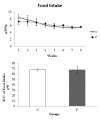Fructose-rich diet leads to reduced aerobic capacity and to liver injury in rats
- PMID: 22713601
- PMCID: PMC3473252
- DOI: 10.1186/1476-511X-11-78
Fructose-rich diet leads to reduced aerobic capacity and to liver injury in rats
Abstract
The main purpose of this research was to investigate the alterations in the aerobic capacity and appearance of metabolic alterations in Wistar rats fed on fructose-rich diet. We separated twenty-eight rats into two groups according to diet: a control group (C) (balanced diet) and a fructose-rich diet group (F). The animals were fed these diets for 60 d (d 120 to 180). We performed insulin, glucose as well as a minimum lactate test, at d 120 and 180. At the end of the experiment, sixteen animals were euthanized, and the following main variables were analysed: aerobic capacity, the serum aspartate aminotransferase (AST) to alanine aminotransferase (ALT) ratio, serum and liver triglyceride concentrations, serum and liver thiobarbituric acid reactive substance (TBARS) concentrations, serum and liver catalase and superoxide dismutase (SOD) activity and haematoxylin-eosin histology (HE) in hepatocytes. The remaining twelve animals were submitted to an analysis of their hepatic lipogenic rate. The animals fed a fructose-rich diet exhibited a reduction in aerobic capacity, glucose tolerance and insulin sensitivity and increased concentrations of triglycerides and TBARS in the liver. Catalase and SOD activities were reduced in the livers of the fructose-fed animals. In addition, the serum AST/ALT ratio was higher than that of the C group, which indicates hepatic damage, and the damage was confirmed by histology. In conclusion, the fructose-rich diet caused significant liver damage and a reduction in insulin sensitivity in the animals, which could lead to deleterious metabolic effects.
Figures






Similar articles
-
The Role of High-Fructose Diet in Liver Function of Rodent Models: A Systematic Review of Molecular Analysis.Iran Biomed J. 2023 Nov 1;27(6):326-39. doi: 10.52547/ibj.3965. Iran Biomed J. 2023. PMID: 38193285 Free PMC article.
-
Exercise counteracts fatty liver disease in rats fed on fructose-rich diet.Lipids Health Dis. 2010 Oct 14;9:116. doi: 10.1186/1476-511X-9-116. Lipids Health Dis. 2010. PMID: 20946638 Free PMC article.
-
High dietary salt decreases antioxidant defenses in the liver of fructose-fed insulin-resistant rats.J Nutr Biochem. 2013 Dec;24(12):2016-22. doi: 10.1016/j.jnutbio.2013.06.006. Epub 2013 Oct 14. J Nutr Biochem. 2013. PMID: 24135554
-
Reduced-calorie avocado paste attenuates metabolic factors associated with a hypercholesterolemic-high fructose diet in rats.Plant Foods Hum Nutr. 2014 Mar;69(1):18-24. doi: 10.1007/s11130-013-0395-4. Plant Foods Hum Nutr. 2014. PMID: 24249159
-
Fructose as a key player in the development of fatty liver disease.World J Gastroenterol. 2013 Feb 28;19(8):1166-72. doi: 10.3748/wjg.v19.i8.1166. World J Gastroenterol. 2013. PMID: 23482247 Free PMC article. Review.
Cited by
-
Strength Training Prevents Hyperinsulinemia, Insulin Resistance, and Inflammation Independent of Weight Loss in Fructose-Fed Animals.Sci Rep. 2016 Aug 4;6:31106. doi: 10.1038/srep31106. Sci Rep. 2016. PMID: 27487746 Free PMC article.
-
Nonlinear association between AST/ALT ratio and 28-day all-cause mortality following ICU admission in critically ill cirrhotic patients: a retrospective cohort study.BMC Gastroenterol. 2025 May 13;25(1):367. doi: 10.1186/s12876-025-03966-0. BMC Gastroenterol. 2025. PMID: 40360992 Free PMC article.
-
The Role of High-Fructose Diet in Liver Function of Rodent Models: A Systematic Review of Molecular Analysis.Iran Biomed J. 2023 Nov 1;27(6):326-39. doi: 10.52547/ibj.3965. Iran Biomed J. 2023. PMID: 38193285 Free PMC article.
-
Muscle glycogen metabolism changes in rats fed early postnatal a fructose-rich diet after maternal protein malnutrition: effects of acute physical exercise at the maximal lactate steady-state intensity.Diabetol Metab Syndr. 2014 Nov 6;6(1):118. doi: 10.1186/1758-5996-6-118. eCollection 2014. Diabetol Metab Syndr. 2014. PMID: 25400700 Free PMC article.
-
Catalase deletion promotes prediabetic phenotype in mice.Free Radic Biol Med. 2017 Feb;103:48-56. doi: 10.1016/j.freeradbiomed.2016.12.011. Epub 2016 Dec 8. Free Radic Biol Med. 2017. PMID: 27939935 Free PMC article.
References
-
- Hanley AJG, Williams K, Festa A, Haffner SM, D'Agostino. Markers and development of the metabolic syndrome. In The insulin resistance atherosclerosis study. Diabetes. 2005;54(Suppl. 11):3140–3147. - PubMed
-
- Angulo P, Keach JC, Batts KP, Lindor KD. Independent predictors of liver fibrosis in patients with nonalcoholic steatohepatitis. Hepatology. 1999;30(Suppl. 6):1356–1362. - PubMed
-
- Clark JM, Brancati FL, Diehl AM. The prevalence and etiology of elevated aminotransferase levels in the United States. Am J Gastroenterol. 2003;98:960–967. - PubMed
-
- Saltiel AR, Khan R. Insulin signalling and the regulation of glucose and lipid metabolism. Nature. 2001;414:799–806. - PubMed
Publication types
MeSH terms
Substances
LinkOut - more resources
Full Text Sources
Medical

